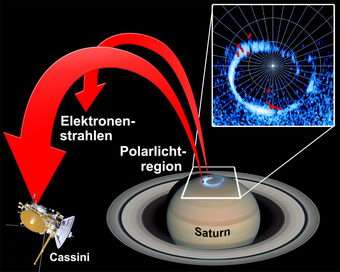Electrons flying 'backwards' in Saturn's sky

We can see polar lights on Earth when electrons above the atmosphere are accelerated downwards. They light up when they hit the upper atmosphere. Some years ago, researchers discovered that electrons inside the polar region can also be accelerated away from the Earth - that is, "backwards". These anti-planetary electrons do not cause the sky to light up, and scientists have been puzzled about how they originate.
Until now it has also been unclear whether anti-planetary electrons only occur on Earth. An international team led by Joachim Saur at the University of Cologne have now found electrons on Saturn that are accelerated "backwards" - that is, in an anti-planetary direction. These particles were measured using "Magnetospheric Imaging Instruments" (MIMI) on NASA's Cassini Space Probe. One of these instruments' sensors, the "Low Energy Magnetospheric Measurement System" (LEMMS), was developed and built by scientists at the Max Planck Institute for Solar System Research.
The rotation of the space probe helped the researchers to determine the direction, number, and strength of the electron rays. They compared these results with recordings of the polar region and a global model of Saturn's magnetic field. It turned out that the region of polar light matched up very well with the lowest point of the magnetic field lines in which electron rays were measured.
Because the electron ray is strongly focussed (with an angle of beam spread less than 10 degrees), the scientists were able to determine where its source lies: somewhere above the polar region, but inside a distance of maximum five radii of Saturn. Because the electron rays measured on the Earth, Jupiter, and Saturn are so similar, it appears that there must be some fundamental process underlying the creation of polar lights.
Doing these measurements, Norbert Krupp and his colleagues Andreas Lagg and Elias Roussos from the Max Planck Institute for Solar System Research worked closely with scientists from the Institute for Geophysics and Meteorology at the University of Cologne and the Applied Physics Laboratory of Johns Hopkins University in Baltimore. US scientists led by Tom Krimigis are responsible for service and coordination of the instrument on the Cassini Space Probe.
Original work: J. Saur, B.H. Mauk, D. G. Mitchell, N. Krupp, K.K. Khurana, S. Livi, S. M. Krimigis, P. T. Newell, D. J. Williams, P.C. Brandt, A. Lagg, E. Roussos, M. K. Dougherty, Electron beams at Saturn indicate universality of anti-planetward auroral acceleration, Nature, 439, 699-702 (09 Feb 2006)
Source: Max-Planck-Gesellschaft


















